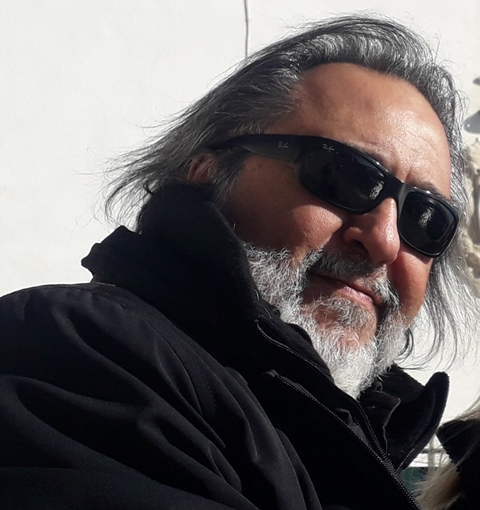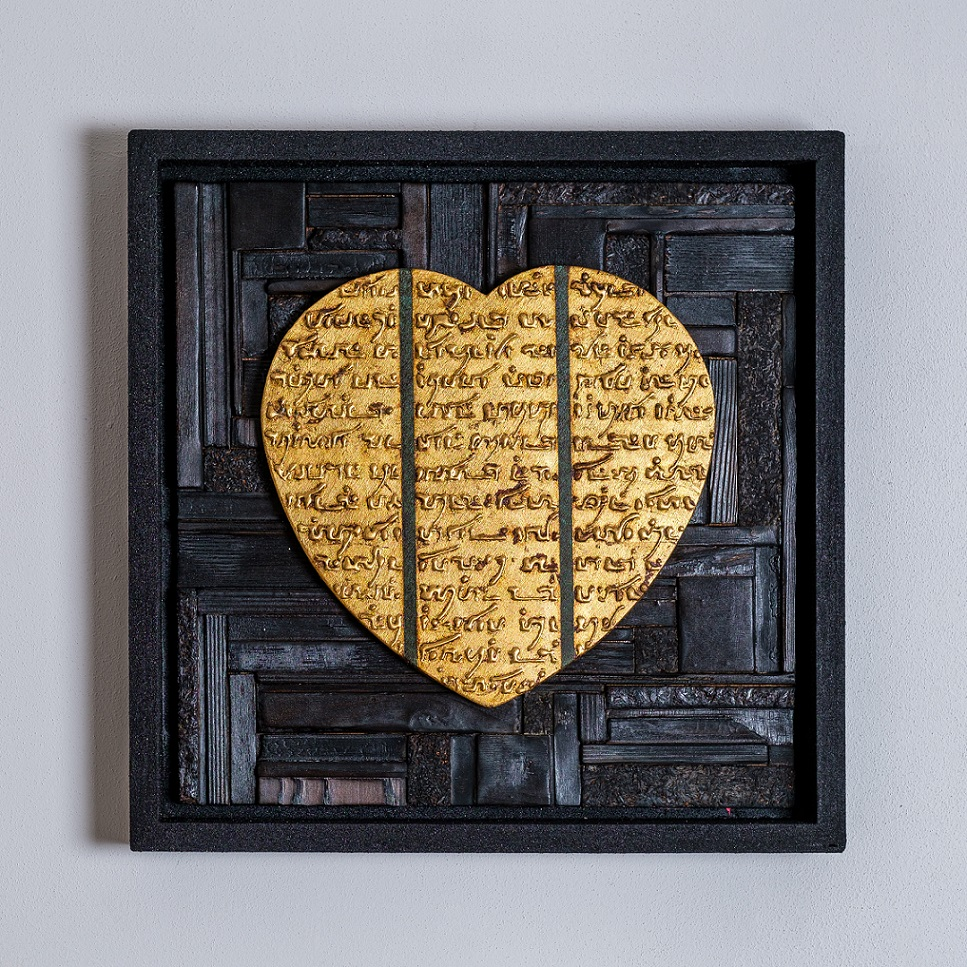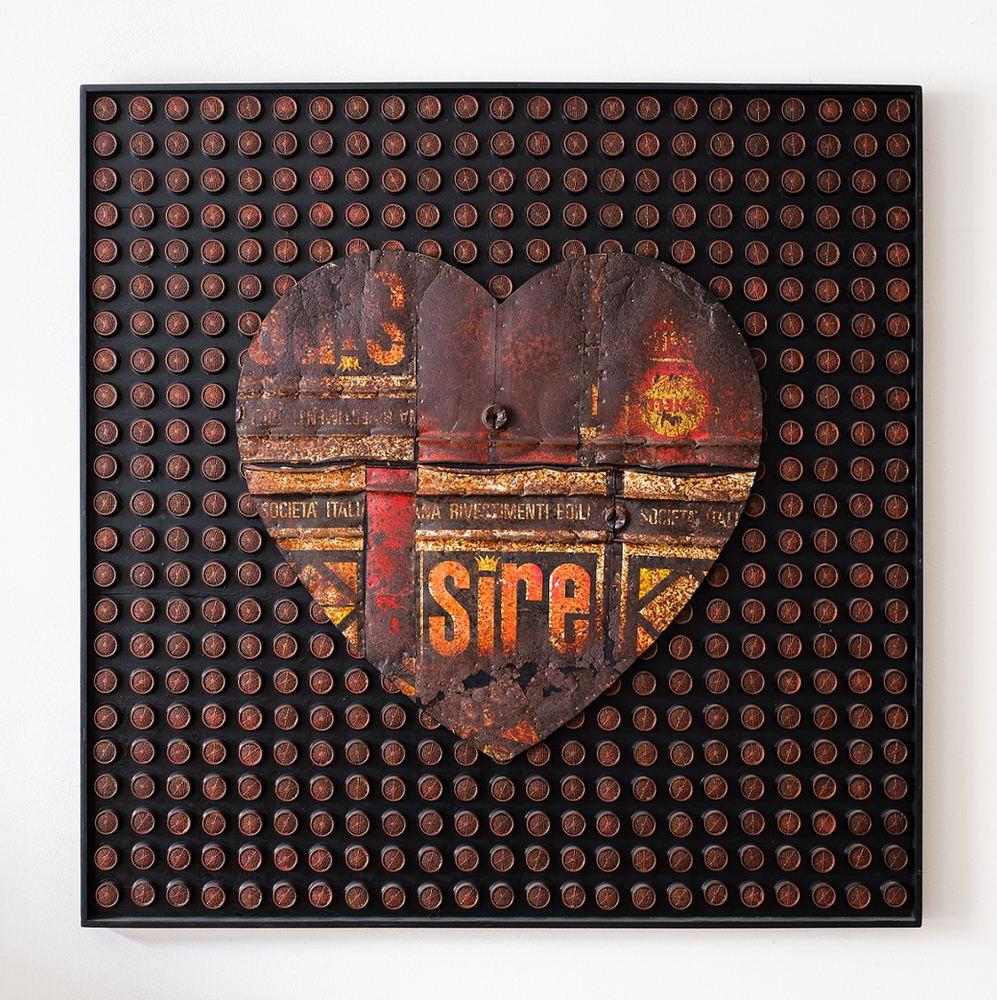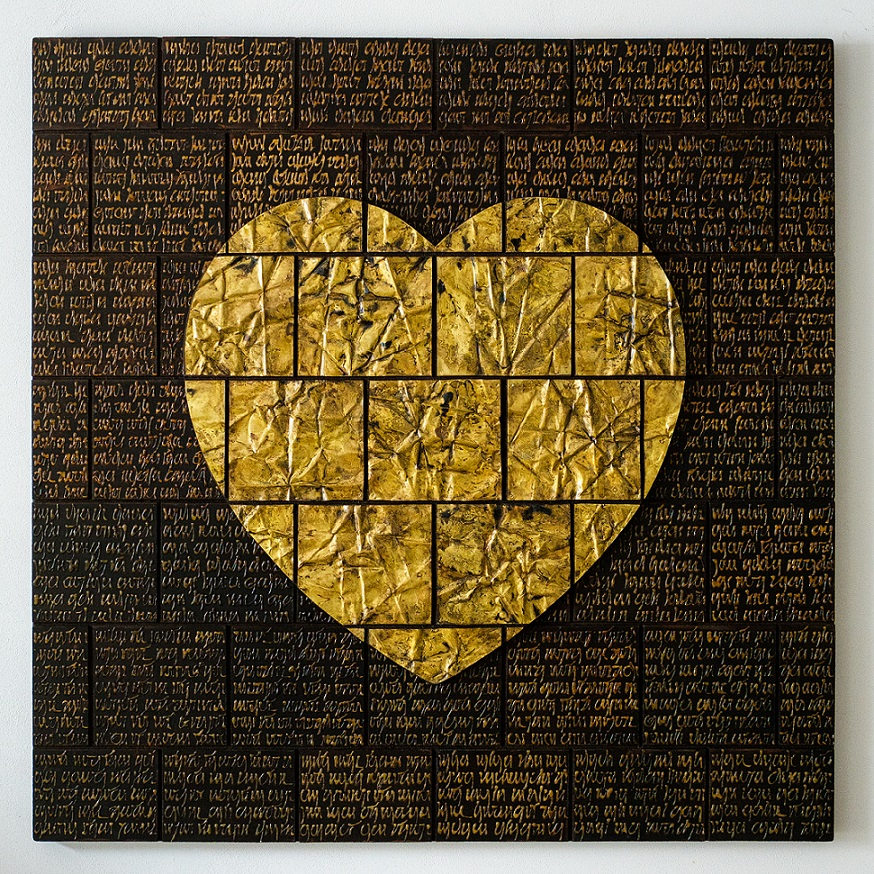
Fabio Masotti
Esiste una linea sottile che unisce le professioni con una forte inclinazione creativa, come l’architettura e il design, e il campo più strettamente artistico, quello cioè in cui l’espressione della propria interiorità o del proprio impulso a comunicare prevalgono su tutto, persino sul mantenimento di quelle regole e limiti matematici e strutturali a cui le professioni succitate devono necessariamente attenersi. Fabio Masotti ha effettuato quel percorso che lo ha condotto a spostarsi gradualmente dalla sua specializzazione di designer di interni, nella quale non poteva fare a meno di manifestare la sua forte inclinazione creativa, a quella di artista forse perché non poteva accettare limiti di alcun tipo alla sua necessità di comunicare, narrare e condividere concetti, emozioni e pensieri, o forse semplicemente perché sentiva che la sua strada, quella in virtù della quale avrebbe potuto soddisfare la sua natura curiosa e sperimentatrice, non poteva che essere quella artistica. Il suo percorso infatti è stato contraddistinto da studi e di sfide attraverso le quali si è misurato con differenti stili, dal Surrealismo del primo periodo all’Informale Materico degli anni Ottanta fino a giungere a un linguaggio distinguibile e personale che lo caratterizza oggi. Per lui l’opera non può limitarsi a conquistare lo sguardo e a suscitare emozioni nel fruitore bensì deve anche essere spunto di riflessione, deve indurre ad andare oltre il visibile e condurre verso un’interiorità, una meditazione sull’esistenza essenziale a prendere atto di ciò che l’individuo è in rapporto a se stesso ma anche alle forze che ruotano intorno a lui, quelle più sottili, quelle più spirituali che lo pongono in connessione con tutto ciò che in superficie non viene visto, non appare. Fabio Masotti si muove tra astrazione e figurazione, tra ricerca concettuale funzionale a stimolare l’analisi profonda dell’immagine complessiva e l’attrazione esercitata da un’icona Pop, cioè il cuore, che è assoluto protagonista di tutte le sue opere e che, attraverso un simbolo conosciuto e ammaliante, spinge l’osservatore a entrare in contatto con un’interiorità diversa, più ampia, più globale rispetto a quella del singolo sentire. Nell’ultima produzione Masotti si interroga sulla spiritualità, sulla religione intesa in senso ampio, soprattutto la esplora dal punto di vista della necessità tutta umana di trovare risposte che non riesce a trovare in se stesso, quel bisogno a volte irrefrenabile di aggrapparsi a qualcosa di esterno per superare i timori e le paure di una contingenza che lo travolge senza che ne sappia trovare un motivo.

1-10
Il cuore perciò diviene il mezzo, o sarebbe meglio dire chiave, per esplorare qualcosa di più interiore, per domandarsi quanto la religione, qualunque essa sia, costituisca solo un modo per alleviare il senso di impotenza e di disorientamento dell’individuo oppure abbia in sé quel qualcosa che all’uomo manca, quell’approccio differente verso l’altro e verso il mondo in grado di ampliare le sensazioni e le emozioni e di porsi in posizione empatica, di ascolto ma anche di solidarietà emotiva con il diverso da sé.

Quadri
Al di là del significato, il fascino esercitato dalle pittosculture di Fabio Masotti è anche puramente estetico poiché l’armonia dell’icona del cuore entra in dialogo con gli elementi che la circondano, con linguaggi arcaici che sembrano fissarne l’eterna bellezza, con parti di libri che ne costituiscono la memoria del tempo, con la foglia oro che ne arricchisce l’armonia e con parti di metallo che a volte sembrano ingabbiarlo all’interno dei singoli e personali schemi. Andiamo però a conoscere meglio le tematiche e la filosofia espressiva direttamente dalla voce dell’artista.
Il suo percorso artistico affonda le radici nella seconda metà del Novecento, ci vuole raccontare cosa ha determinato il passaggio dalla sua professione di interior designer a quella di artista? Qual è stato il momento determinante, se ce n’è stato uno, oppure quanto è stata essenziale l’esperienza professionale per indurla poi a spostarsi gradualmente verso l’arte?
In realtà si è verificato esattamente l’opposto. Dopo un primo momento in cui da piccolo volevo fare il falegname (e non l’astronauta bada bene…) il mio progetto di vita strettamente legato all’arte era già segnato. La concretezza dei miei genitori fece del tutto per distogliermi da quella malsana idea di una vita che non mi avrebbe sicuramente dato di che sopravvivere incoraggiandomi perciò a intraprendere studi diversi da quelli artistici. Il design e l’architettura degli interni erano quanto di più avvicinabile alla mia esigenza di creare cose dal nulla, di dare forma ai miei pensieri, di costruire oggetti e luoghi con i quali l’uomo potesse entrare in empatia. Devo dire che è stata un’ottima scelta perché si è rivelata una professione che ho svolto con grande passione sebbene sempre e comunque in stretta dipendenza con il mio bisogno di fare arte, soprattutto per quanto riguarda la mia produzione di designer.
Cosa l’ha indotta a passare dal Surrealismo all’Informale Materico, quali le sensazioni che percepiva nella fase di trasformazione del suo stile?
Il Surrealismo ha sancito la mia vocazione di artista rivolta ad indagare l’invisibile, il mondo interiore dell’uomo era decisamente il luogo della mia ricerca. Dal racconto dei sogni all’esplorazione della materia di cui i sogni erano fatti è stato il primo passaggio. La pittura precisa e descrittiva del Surrealismo figurativo ha dovuto lasciare spazio all’anima che necessitava di esprimersi con un nuovo linguaggio che coinvolgesse altri sensi.

1-17
Lei ha sapientemente fuso la popolarità di un simbolo riconoscibile universalmente a un concettualismo che tenderebbe a nascondere inducendo l’osservatore a uno sforzo di approfondimento, ci vuole spiegare meglio il perché di questa scelta? Cosa rappresenta per lei la forma del cuore?
Sono molti anni ormai che la mia ricerca artistica si è appropriata di un simbolo universale e popolare come il cuore, o almeno la forma nella quale tutti lo riconosciamo, per parlare di spiritualità. Credo fosse inevitabile che, scavando a fondo nella natura umana, dovessi arrivare a scoprire lo spirito e avere così, finalmente chiaro, quale poteva essere il mio percorso ed il mio contributo ad un possibile cambiamento delle cose, si perché io credo fermamente nel ruolo politico e sociale dell’artista. Senza un impegno, un progetto o una presa di posizione chiara l’arte rischia di essere solo pura decorazione. Trattare argomenti molto profondi utilizzando una forma conosciuta e riconoscibile che portasse lo spettatore direttamente al cuore dei miei lavori mi ha certamente permesso di fondere il mio progetto concettuale a un messaggio volutamente più popolare, diciamo che, senza voler sembrare un nuovo profeta, è come se la mia arte parlasse avvalendosi di parabole. Infatti la forma del cuore è la sola concessione alla figurazione, un limite che chiede di essere superato per accedere al vero contenuto dell’opera.

1-14
L’ultima mostra Pellegrinaggi era orientata al senso di religiosità ma anche a quello di interazione tra gli individui che si incontrano durante gli spostamenti di vita, l’attuale produzione è un approfondimento e un ampliamento di questo concetto, può esporcelo in maniera più approfondita?
I Pellegrinaggi parlavano di religiosità, intesa in senso laico come ricerca, ma anche di smarrimento, di incertezza del futuro e mai avrei immaginato che l’arrivo del Covid rendesse così drammaticamente attuale tutto questo all’umanità intera. Il virus e la pandemia sono stati per me, come per tanti altri artisti in ogni settore, motivo di profonda riflessione sulla esistenza stessa della vita su questo pianeta. La terra che riprendeva vita ovunque proprio nel momento stesso in cui l’uomo smetteva di abusarla mi ha dato molto da riflettere. È nato così il mio nuovo progetto artistico Dal Sacro al Profano, con l’intento di dimostrare come nella vita tutto sarebbe Sacro se solo l’uomo non lo profanasse con le sue azioni.

1
La vita nasce sacra, il profano è una invenzione umana. Cosa è la profanità se non la mancanza di amore con cui l’uomo tratta tutto ciò che non è sacro ai sui occhi? La pandemia ci ha insegnato a riconoscere la sacralità in ogni cosa proprio nel momento in cui tutto ci veniva tolto, abbiamo capito cosa fosse veramente essenziale e quanto tutto questo dovesse essere tutelato, protetto. Le mie opere nascono come un corale ringraziamento a un qualunque Dio per tutto quello che ci ha donato con la consapevolezza di averlo capito solo quando tutto si è fermato e ho avuto il tempo, e il coraggio, di guardare indietro. Per i miei lavori ho utilizzato materiali profani, ma già carichi di significati e storie proprie, che l’azione dell’artista trasforma in un atto di amore e quindi in opere sacre. Queste opere risultano tali ai nostri occhi pur non avendo nulla di riconducibile ai canoni dell’arte sacra così come tutti la conosciamo. Questo dimostra che il Sacro è in chi guarda, che il Sacro siamo noi.
Quali sono i suoi prossimi progetti?
In questo momento il mio impegno è dare quanta più visibilità possibile al mio progetto di mostra Dal Sacro al Profano altrimenti tutto questo lavoro non avrebbe senso… poi ci sono già nuove idee e nuovi percorsi da intraprendere, ma di questo ne parleremo in un prossimo futuro.
FABIO MASOTTI-CONTATTI
Email: info@fabiomasotti.it
Sito web: http://www.fabiomasotti.it/
Pagina Facebook: https://www.facebook.com/profile.php?id=100004689168481
Marta Lock’s interviews:
Fabio Masotti, from design to spiritual research with art
There is a fine line between professions with a strong creative bent, such as architecture and design, and the more strictly artistic field, where the expression of one’s inner self or one’s impulse to communicate prevails over everything, even over the maintenance of those mathematical and structural rules and limits to which the aforementioned professions must necessarily adhere. Fabio Masotti took the path that led him to gradually move from his specialisation as an interior designer, in which he could not help but express his strong creative inclination, to that of an artist, perhaps because he could not accept limits of any kind to his need to communicate, narrate and share concepts, emotions and thoughts, or perhaps simply because he felt that his path, the one by virtue of which he could satisfy his curious and experimental nature, could only be the artistic one. In fact, his path has been marked by studies and challenges through which he has measured himself with different styles, from the Surrealism of his early period to the Material Informalism of the 1980s, until he arrived at a distinguishable and personal language that characterises him today. For him, an artwork must not be limited to capturing the gaze and arousing the emotions of the viewer, but must also be food for thought. It must induce us to go beyond the visible and lead us towards an interiority, a meditation on existence that is essential to take note of what the individual is in relation to himself but also to the forces that revolve around him, the more subtle, the more spiritual ones that connect him with everything that is not seen on the surface, that does not appear. Fabio Masotti moves between abstraction and figuration, between conceptual research aimed at stimulating deep analysis of the overall image and the attraction exerted by a Pop icon, i.e. the heart, which is the absolute protagonist of all his works and which, through a well-known and bewitching symbol, urges the observer to come into contact with a different, broader, more global interiority than that of the individual feeling. In his latest work Masotti questions spirituality, religion in its broadest sense, and above all explores it from the point of view of the all-too-human need to find answers that he cannot find within himself, that sometimes unstoppable need to cling to something external to overcome the fears and anxieties of a contingency that overwhelms him without him being able to find a reason. The heart therefore becomes the means, or rather the key, for exploring something more interior, for asking oneself to what extent religion, whatever it may be, is merely a way of alleviating the individual’s sense of impotence and disorientation, or does it contain something that man lacks, that different approach to the other and to the world that is capable of amplifying sensations and emotions and of placing oneself in an empathetic position, of listening to but also of emotional solidarity with those different from oneself. Beyond the meaning, the fascination exerted by Fabio Masotti’s pictosculptures is also purely aesthetic, since the harmony of the heart icon enters into dialogue with the elements surrounding it, with archaic languages that seem to fix its eternal beauty, with parts of books that constitute its memory of time, with gold leaf that enriches its harmony and with parts of metal that sometimes seem to cage it within individual and personal schemes. But let’s get to know more about the themes and expressive philosophy directly from the artist’s voice.
Your artistic career has its roots in the second half of the twentieth century. Will you tell us what determined the transition from your profession as an interior designer to that of an artist? What was the decisive moment, if there was one, or how essential was the professional experience for you to gradually move towards art?
Actually, exactly the opposite occurred. After an initial moment when, as a child, I wanted to be a carpenter (and not an astronaut, mind you…), my life project closely linked to art was already marked out. The concreteness of my parents did everything they could to divert me from that unhealthy idea of a life that would certainly not have given me enough to survive, encouraging me to undertake studies different from art. Design and interior architecture were the closest I could get to my need to create things out of nothing, to give shape to my thoughts, to build objects and places with which people could empathise. I have to say that it was a good choice because it turned out to be a profession that I carried out with great passion, even though always linked to creativity and, in any case, I have to say that it was a very good choice because it turned out to be a profession that I carried out with great passion, although always in close dependence with my need to make art, especially with regard to my production as a designer.
What led you to move from Surrealism to Material Informalism, what were the feelings you perceived during the transformation of your style?
Surrealism sanctioned my vocation as an artist to investigate the invisible, the inner world of man was definitely the place of my research. From the telling of dreams to the exploration of the material of which dreams were made was the first step. The precise and descriptive painting of figurative Surrealism had to leave room for the soul that needed to express itself in a new language involving other senses.
You have skilfully fused the popularity of a universally recognisable symbol with a conceptualism that would tend to conceal it, inducing the observer to make an effort to delve deeper, would you like to explain why this choice was made? What does the shape of the heart represent for you?
For many years now, my artistic research has appropriated a universal and popular symbol such as the heart, or at least the form in which we all recognise it, to talk about spirituality. I think it was inevitable that, by digging deep into human nature, I should discover the spirit and thus finally have a clear idea of my path and my contribution to a possible change in things, because I firmly believe in the political and social role of the artist. Without a commitment, a project or a clear position, art risks being mere decoration. Dealing with very profound issues using a familiar and recognisable form that takes the viewer directly to the heart of my work has certainly allowed me to merge my conceptual project with a deliberately more popular message, let’s say that, without wanting to sound like a new prophet, it is as if my art spoke using parables. In fact, the shape of the heart is the only concession to figuration, a limit that needs to be overcome to access the true content of the artwork.
The last exhibition, Pellegrinaggi, was oriented towards a sense of religiosity but also towards the sense of interaction between individuals who meet during their life journeys; the current production is a deepening and expansion of this concept, can you explain it to us in more detail?
The Pellegrinaggi spoke of religiosity, understood in a secular sense as a quest, but also of bewilderment, of uncertainty of the future, and I would never have imagined that the arrival of Covid would make all this so dramatically relevant to the whole of humanity. The virus and the pandemic were for me, as for many other artists in every sector, a reason for deep reflection on the very existence of life on this planet. The earth coming back to life everywhere at the very moment man stopped abusing it gave me much food for thought. This is how my new artistic project Dal Sacro al Profano (From the Sacred to the Profane) was born, with the intention of demonstrating how everything in life would be sacred if only man did not profane it with his actions. Life is born sacred, the profane is a human invention. What is profanity if not the lack of love with which man treats everything that is not sacred in his eyes? The pandemic taught us to recognise the sacredness of everything at the very moment when everything was being taken away from us, we understood what was truly essential and how all this had to be safeguarded, protected. My artworks are born as a choral thanksgiving to any God for all that he has given us, with the awareness that I understood it only when everything stopped and I had the time, and the courage, to look back. I have used profane materials for my artworks, but they are already loaded with their own meanings and stories, which the artist’s action transforms into an act of love and therefore into sacred works. These works are sacred to our eyes even though they have nothing to do with the canons of sacred art as we all know it. This shows that the sacred is in the beholder, that the sacred is us.
What are your next projects?
At the moment my commitment is to give as much visibility as possible to my exhibition project Dal Sacro al Profano (From the Sacred to the Profane), otherwise all this work would be pointless… then there are already new ideas and new paths to take, but we will talk about this in the near future.
